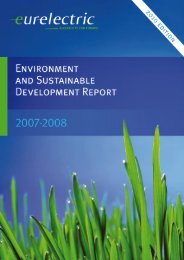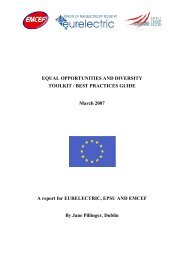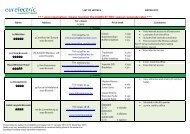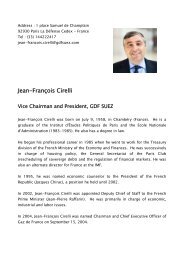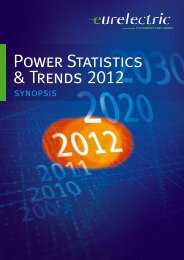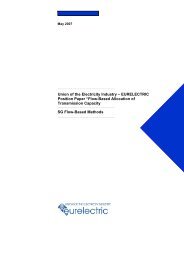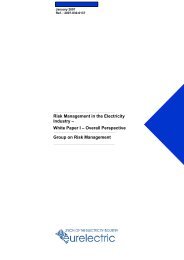Letter to Commissioners - Eurelectric
Letter to Commissioners - Eurelectric
Letter to Commissioners - Eurelectric
Create successful ePaper yourself
Turn your PDF publications into a flip-book with our unique Google optimized e-Paper software.
Brussels, 8 February 2012<br />
<strong>Letter</strong> addressed <strong>to</strong><br />
Commissioner C. Hedegaard<br />
Commissioner G. Oettinger<br />
Commissioner A. Tajani<br />
POLICY COHERENCE: CONFLICTING MESSAGES ON FUNDAMENTAL METHODOLOGY FOR ENERGY-USING<br />
PRODUCTS<br />
Dear Commissioner,<br />
We write regarding the review of the classes of energy-using products covered by the Ecodesign and Energy Labelling<br />
Directives. Our companies are concerned about conflicting messages received, and negative impact on the investment<br />
climate.<br />
In December 2011 the European Commission released the Final Report “Methodology for Ecodesign of Energy-related<br />
Products” (MEErP). According <strong>to</strong> the project website, it provides the Commission with an update and extension of the<br />
existing methodology for the Ecodesign of Energy-using Products (MEEuP). 1<br />
EURELECTRIC is surprised <strong>to</strong> see that the MEErP report establishes that renewable energy sources (RES) have had, and<br />
will have, no impact in reducing primary energy use in electricity generation – past, present or future. Accordingly, we<br />
are disappointed that the report therefore proposes <strong>to</strong> penalise the use of electricity in energy-using products, and in<br />
this way promotes the direct-use of carbon emitting technologies, like petrol or gas in heating.<br />
We now understand that the Commission Services in charge of Ecodesign and Energy Labelling are in the process of<br />
drafting regulations for products that will codify the MEErP report in<strong>to</strong> EU law.<br />
Does this mean that the Commission is of the opinion:<br />
That over the next 30 <strong>to</strong> 50 years the volume of primary energy needed <strong>to</strong> generate electricity will remain<br />
substantially unchanging, and thus current EU policies (RES, ETS, IED) will have little or no impact on the power<br />
sec<strong>to</strong>r?<br />
That the 2020 RES target in particular will have no impact on primary energy needed, thus having no impact on<br />
improving security of supply? If this is the case, we ask how it is RES can contribute <strong>to</strong> reducing carbon emissions<br />
in the power sec<strong>to</strong>r?<br />
That reducing direct GHG emissions in households and transport “little-by-little” or “step-by-step” by means of<br />
investment cycles taking 10 <strong>to</strong> 30 years (in the heating sec<strong>to</strong>r) will deliver the 2050 objectives?<br />
EURELECTRIC is strongly committed <strong>to</strong> meeting the EU 2020 climate and energy targets and – with an adequate policy<br />
framework <strong>to</strong> enable cost-effective investments in low-carbon technologies – committed <strong>to</strong> the 2050 goals. We<br />
believe that decarbonisation will require a paradigm shift in energy end-use and that, as recently recognised by the<br />
European Environment Agency, electricity has a major role <strong>to</strong> play. Electricity has no direct carbon emissions at the<br />
point of consumption and its end-user indirect emissions are capped and progressively reducing under the ETS. 2<br />
1 http://ec.europa.eu/enterprise/policies/sustainable-business/ecodesign/methodology/index_en.htm<br />
and www.meerp.eu/index.html<br />
2 “End-user GHG emissions from energy”, Technical Report No 19/2011: www.eea.europa.eu/publications/end-use-energyemissions?utm_source=EEASubscriptions&utm_medium=RSSFeeds&utm_campaign=Generic<br />
Union of the Electricity Industry - EURELECTRIC AISBL . Boulevard de l’Impératrice, 66 - bte 2 . B - 1000 Brussels . Belgium<br />
Tel: + 32 2 515 10 00 . Fax: + 32 2 515 10 10 . VAT: BE 0462 679 112 . www.eurelectric.org
We therefore urge that, in order for the Commission <strong>to</strong> deliver on the EU vision, Europe cannot afford <strong>to</strong> squander<br />
resources by investing in assets (appliances, infrastructures) that will become stranded within a decade. This is<br />
particularly true at a time of financial difficulty for governments, citizens and business.<br />
I propose a meeting between your and our experts <strong>to</strong> find ways <strong>to</strong> ensure policy coherency on the role of energyusing<br />
products, starting with the current programme of work on Ecodesign and Energy Labelling.<br />
Yours sincerely,<br />
Hans ten BERGE<br />
Secretary General<br />
Encl : 1 Annex
Annex<br />
On Page 54 of “Methodology for Ecodesign of Energy-related Products - MEErP 2011, Methodology Report, Part 2:<br />
Environmental policies & data”, Final Report 3 , it is stated:<br />
Following initial debates, the fixed efficiency value of 40% actually used in the prepara<strong>to</strong>ry studies was a long term<br />
average over the product life of most products (i.e. over the period 2005-2025). The primary energy fac<strong>to</strong>r pertaining<br />
<strong>to</strong> this efficiency is 2.5 (1 kWh electric = 2.5 kWh primary energy).<br />
For the period up <strong>to</strong> 2030, i.e. when analyzing products with a life less than 20 years, the fac<strong>to</strong>r 2.5 still seems a robust<br />
fixed value <strong>to</strong> be used in prepara<strong>to</strong>ry studies. According <strong>to</strong> PRIMES, the average efficiency of conventional thermal<br />
power plants is progressing only slowly. The share of renewable energy sources and natural gas will increase, but the<br />
increased use of biomass, coal and nuclear energy will reduce this positive effect.<br />
For building components with a product life of 40-50 years, like window frames, insulation panels, etc., the primary<br />
energy conversion fac<strong>to</strong>r of 2.4 (efficiency 41.7%) can be assumed.<br />
The above-mentioned three paragraphs contain an impressive amount of imprecise or wrong statements. Specifically:<br />
First paragraph: it is said that 2.5 is based on “long term average”. However, all evidence shows that primary energy<br />
content in electricity has constantly reduced over time. Last data available showed that the EU average was close <strong>to</strong><br />
2.5 already in 2009. The impact of 2020 targets (RES, ETS) and other environmental legislation (IED) will impact<br />
furthermore the his<strong>to</strong>rical trend. If 2.5 is the long term average, then no additional improvements are expected in<br />
electricity systems.<br />
Second paragraph: references <strong>to</strong> PRIMES model are all systematically wrong. In particular:<br />
The second sentence “According <strong>to</strong>… slowly” is technically correct, but it omits <strong>to</strong> say that the share of<br />
conventional thermal power plants reduces. But electricity is generated not only by these plants: the growing<br />
share of RES, and the impact it will have on reducing primary energy use, is ignored;<br />
The third sentence is wrong in two aspects:<br />
o In any of the scenarios produced by the European Commission since 2002 coal and nuclear share will<br />
grow in the long term;<br />
o The definition of thermal power plants in PRIMES includes natural gas, biomass and coal. The<br />
sentence is therefore irrelevant in arguing for effects compensating the role of RES: the RES share<br />
will grow, the share of conventional power plants will reduce while the overall efficiency of thermal<br />
technologies will remain substantially the same. But as the share reduces, the primary energy<br />
needed reduces as well.<br />
Third paragraph: this reflects the wrong assumption made in the previous two paragraphs, where it is wrongly<br />
assumed that electricity generation is equal <strong>to</strong> thermal electricity generation.<br />
3 http://www.meerp.eu/downloads/MEErP%20Methodology%20Part%202%20Final.pdf



